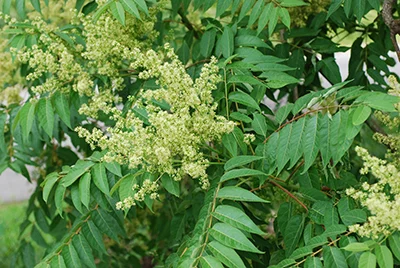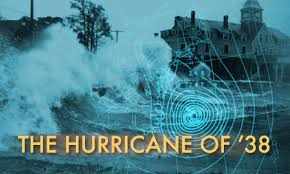
Maggie Kimball: Tree of heaven's hellish effects on the environment
The tree of heaven, known also as stinking sumac, (USDA photo)
Adored for its beauty and ease of growth, and despised for its harmful, everlasting effects, the tree of heaven truly is glorious. Although it's deserving of our admiration for its aesthetics, New England statesmust hop on board to regulate the distribution of this invasive tree, to combat its negative impacts within diverse ecosystems.
With a name like “tree of heaven,” one could form a mental picture of a gorgeous, heavenly tree. One with luscious budding flowers, attractive bark and magnificent leaves extending from a sky-piercing trunk. These imaginative assumptions are true for tree of heaven’s appearance. Its godly strength and resistance to disturbance lets it stand out as a glimpse of a lifeform within a concrete jungle.
While in a city setting this tree is able to thrive, but its ability to also thrive in environments holding an abundance of native plants makes this tree destructive. What lacks from its physical appearance is this species’ inner demons that are far more damaging than its exterior suggests.
Within a diverse ecosystem, this tree will not only outcompete surrounding species for resources, it will actually poison and kill them.
The tree of heaven, known also as Chinese sumac and stinking sumac, is an aggressive invasive species taking over the United States state by state. According to the U.S. Department of Agriculture, tree of heaven has invaded 41 of the 50 states and has extended its reach through much of Canada, since its introduction, in 1784.
First planted on an estate in Pennsylvania by William Hamilton, it was introduced to New York City some 40 years later. Since its preface to city streets, tree of heaven has been able to establish itself as a pioneer species, successfully surviving amongst minimal resources where other species cannot. It has the ability to tolerate saline soils, air pollution, a range of soil pH and drought, making it a perfect tree for city habitat.
Where air pollution is highly concentrated and natural flora is scarce, it's incredibly important to find a species that can withstand such conditions. In a flourishing, diversified area with optimal resources for many species to live in, such as southern New England, this plant becomes a noxious invader. A characteristic of some highly invasive species is allelopathy: a host of chemicals a plant releases into the environment that act as a germination and growth inhibitor.
According to The Nature Conservancy, the bark, roots and leaf litter of tree of heaven contain an allelopathic chemical known as ailanthone. The tree uses this biochemical to prevent other plants from establishing and also disrupts the growth rates of existing native plants.
Like many invasive species, tree of heaven likes to establish itself in disturbed areas such as forest edges, roadsides and wastelands. This is a cause for concern because if it has established itself in an area such as a forest edge, it will most certainly encroach on the native flora, and over time reduce the diversity of plant life in the area.
A change in plant diversity will alter the abundance and diversity of wildlife within the area, because natural food sources will be removed. Not only will it kill the surrounding species, by releasing up to 400,000 wind-dispersed seeds a year, according to the U.S. Forest Service, this tree will be able to further establish itself in the disturbed open areas where it had previously killed off native plants.
Although tree of heaven is registered as an invasive species, Rhode Island has failed to prohibit the human distribution of this invasive species. The state of Rhode Island is in essence allowing greater potential for the tree to invade vital ecosystems that Rhode Islanders hold dear, and putting native species in danger.
I urge the Rhode Island Department of Environmental Management to list the tree of heaven as not only an invasive and noxious plant, but to also prohibit the possession, transport, planting and propagation of the tree to further ensure the safety of Rhode Island’s native plants.
Maggie Kimball is a University of Rhode Island student studying wildlife conservation and biology.
Robert Whitcomb: Too much wind for too much wood on Sept. 21, 1938
“The roaring wind toppled forests in every New England state, with New Hampshire and Massachusetts (east of the eye of the storm) hit particularly hard. The path of destruction spanned ninety miles across....’’ And “70 percent or more of the toppled timber was Pinus strobus – eastern white pine’’ – the most valuable (and vulnerable) tree crop in New England because of its height, straightness and its many uses, from lumber to make houses, to furniture to cheap shipping boxe
(Original review published by The Weekly Standard)
When I was a boy living in coastal Massachusetts I frequently heard stories about the great hurricane that crashed into Long Island and New England on Sept. 21, 1938. Most of the people who described it to me – my father and some of his friends -- were only in their thirties and early forties when they told me about it, and had very vivid stories, especially after a few drinks."
What the 1906 earthquake is to San Francisco, the 1871 fire is to Chicago and Hurricane Katrina is to New Orleans, the ’38 Hurricane (aka “The Long Island Express’’) is to New England and Long Island.
Given the scale of the catastrophe in one of the most populous and richest parts of the country, the ’38 Hurricane at first got surprisingly little attention from the rest of the country because attention was riveted on the Munich Crisis; many assumed that war was about to break out in Europe; of course, that wouldn’t be for another year.
The storm killed around 700 people and destroyed many buildings, bridges and miles of road. Its tidal surge altered long stretches of the southern New England and Long Island coasts.
Stephen Long clearly and dramatically, and sometimes with droll humor, details the mayhem produced by torrential rain followed by winds that gusted to nearly 200 miles an hour on Blue Hill, south of Boston. He serves up a mix of regional history, meteorology, botany, ecology, politics, economics -- allseasoned with anecdotes.
But his book is mostly about the trees that the storm took down, especially in New England’s large and well-established second-growth forests and “the pastoral combination of farm field and forest {that} adorned’’ the region, interspersed by villages with steepled white churches. That’s the (unrepresentative) scene that many tourists most associate with the region. The storm’s massive blowdowns (including of steeples) altered the views in many places.
As a boy, I saw evidence of this damage in the woods next to our house, where there were numerous pits where the roots of uprooted trees had been. From the pits’ shape you could tell which direction the strongest wind came – southeast, at more than 100 miles an hour. And there were still many gaps in the woods where tall trees had once stood.
Mr. Long, founder and former editor of Northern Woodlands magazine, focuses on the ecological, economic and sociological effects of the storm’s destruction of mature trees in a wide swath of New England.
“The roaring wind toppled forests in every New England state, with New Hampshire and Massachusetts (east of the eye of the storm) hit particularly hard. The path of destruction spanned ninety miles across....’’ And “70 percent or more of the toppled timber was Pinus strobus – eastern white pine’’ – the most valuable (and vulnerable) tree crop in New England because of its height, straightness and its many uses, from lumber to make houses, to furniture to cheap shipping boxes. (Mr. Long describes how mighty New England’s cheap-pine-box industry was before heavy-duty cardboard and plastic took its place.)
All this devastated many landowners, already brought low by the Great Depression, who depended on pine sales from their wood lots to make ends meet.
Also torn up were many maple-tree stands, the sap from which provided a lot of extra income to New England farmers and other landowners.
Mr. Long writes very accessibly about why certain trees sustained far more damage than others -- e.g., “The taller the tree the longer the lever and the greater the force it can exert on the ground where it’s anchored.’’ Trees on southeast-facing slopes were particularly vulnerable.
Enter the New Deal, in an example of what perhaps only government can do: Clean up damage from natural disasters that extends over many square miles. Much praise was due the U.S. Forest Service, as well as Franklin Roosevelt’s Works Progress Administration and the Civilian Conservation Corps, in responding to a disaster as huge as the ’38 Hurricane.
The first imperative, state and federal officials and an anxious public thought, was to reduce the chances of massive forest fires from the downed and thus drying trees and branches. Indeed, some of the forests were closed to the public for long stretches after the hurricane for fear of fire. That the hurricane had made many of the fire-watch towers inaccessible -- roads were blocked by fallen trees – made it that much scarier.
And so, Mr. Long explains, federal officials, led by the U.S. Forest Service, pulled together the resources of various organizations but especially thousands of otherwise unemployed men working for the CCC (young men) and the WPA (which had older men too). They opened roads and helped clean out much of the combustible debris left on the ground by the hurricane.
The Roosevelt administration pushed the project. Mr. Long describes “the WPA’s own portrayal of its hurricane relief efforts, as seen in an eleven-minute film….Shock Troops of Disaster bears a striking resemblance to wartime newsreels, depicting feverish activity accompanied by charged music and stentorian narration. Referring to the WPA, the narrator described it in this way: ‘Manpower, turning from regular public improvements and services into the breach in times of dire need.’’’
But what to do with the fallen timber taken out of the woods, which could flood the market and lower the already low price of the wood? To address this issue, the government invaded the private market with a vengeance.
Mr. Long explains: “The Forest Service saw the need for a stabilizing influence on the price of logs and the flow of lumber to the market….{so it} put the power of the federal government to work’’ by establishing “a fair price for logs,’’ and buying up all it could and then gradually selling it as “demand required. At the heart of this reasoning was that the purchasing program would allow thousands of local landowners to realize a decent return from what could have been a nearly total economic loss.’’
“The total cost of the salvage program was $16,269,000’’ {in dollars of the time}, of which 92 percent was recovered by the government. It seems doubtful that such market intervention will happen after the next big hurricane blows through. But then, FDR & Co. saw the hurricane response as another way of fighting the Depression.
The cleanup showed just how good Americans, via a collaboration of the private and public sectors, can be at addressing an emergency – as they were soon to prove after Pearl Harbor. And a lot of that hurricane wood was used in war-related products and then in the post-war building boom.
Meanwhile, with the continuing disappearance of farmland, New England is now more forested than at any time in 200 years. Some year, the Northeast will again have a record surplus of lumber on the ground after another huge hurricane. We may then long for a CCC and a WPA.
Robert Whitcomb (rwhitcomb51@gmail.com) is overseer of newenglanddiary.com.


















